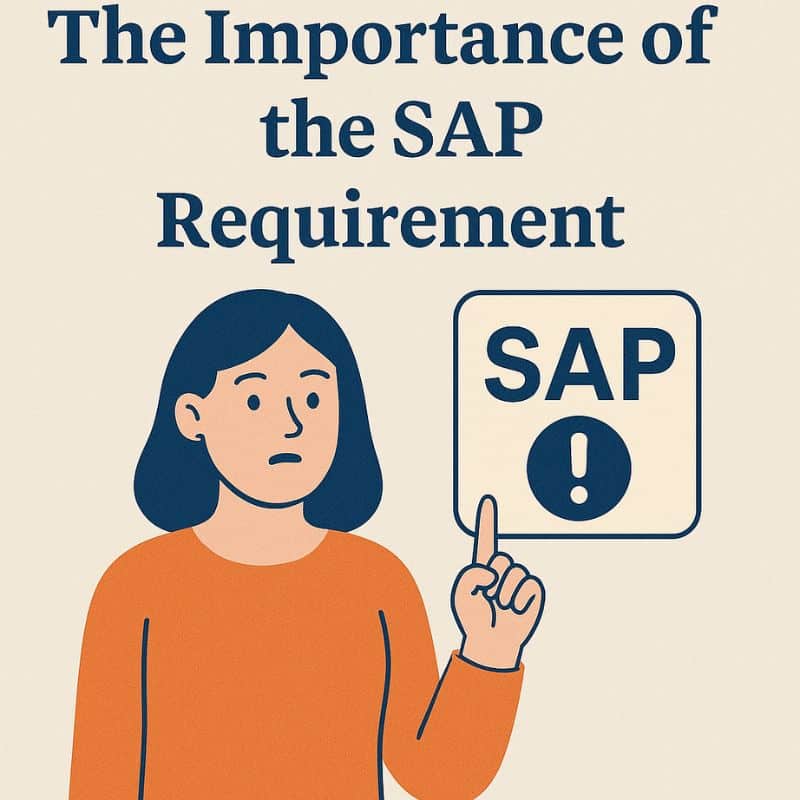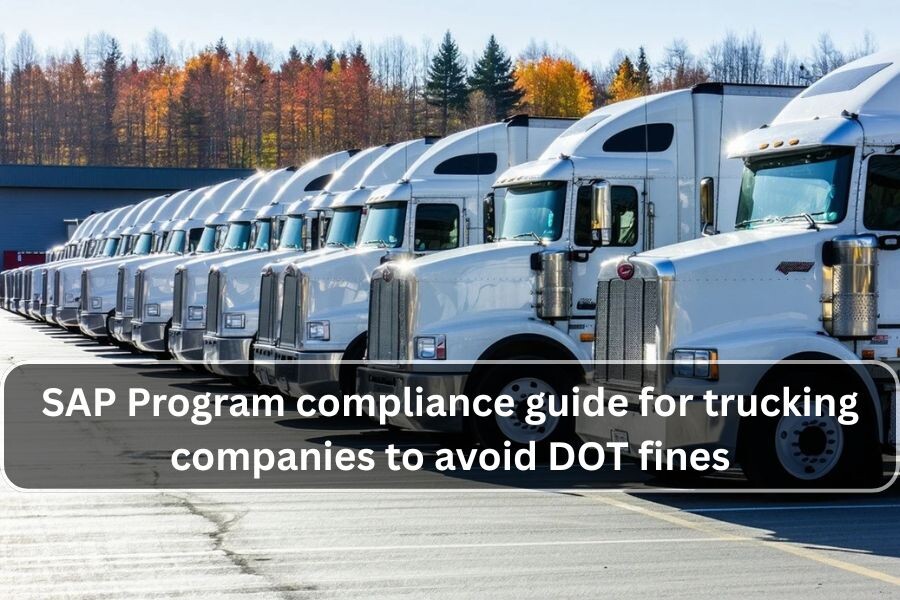Failing a drug test as a (Commercial Driver’s License) CDL driver can be a devastating experience. It not only disrupts your career but also raises concerns about your ability to return to work in an industry governed by strict guidelines. However, there is a structured pathway to help get you back on the road. One critical step in this process is completing a SAP (Substance Abuse Professional) evaluation. Understanding the importance of this evaluation and how it fits into the return-to-duty process can make all the difference when rebuilding your career.
This article explores the key reasons why completing a SAP Evaluation is essential. What the process entails, and how it can help you move forward after failing a drug test.
Understanding the Consequences of a Failed Drug Test
Failing a drug test as a CDL driver carries serious consequences. The Department of Transportation (DOT) mandates strict drug and alcohol testing requirements to ensure public safety. When you fail a drug test, whether it’s during pre-employment, random testing, or post-accident screenings, the results are reported to the DOT Clearinghouse. Here’s what happens next:
Immediate Removal from Safety-Sensitive Duties
According to DOT regulations, failing a drug test means you cannot perform safety-sensitive duties, including operating commercial vehicles. This policy ensures that the roads remain safe for everyone.
- Notification to Your Employer: Your employer is required to remove you from your position immediately. CDL drivers are expected to operate with the utmost responsibility, and substance misuse is incompatible with these duties.
- Impact on Future Employment: Failed test results are recorded in the DOT Drug and Alcohol Clearinghouse for five years or until you complete the return-to-duty process. Prospective employers will have access to this record, potentially making it difficult to secure new opportunities until corrective steps are taken.
While this situation feels overwhelming, CDL drivers need to know there is a structured process to regain compliance, re-enter safety-sensitive roles, and rebuild their careers.
What Is a SAP Evaluation?
A SAP evaluation is a standardized process designed to ensure that CDL drivers who violate DOT drug and alcohol regulations receive proper assessment and guidance. The Substance Abuse Professional (SAP) plays a pivotal role in evaluating your condition and providing recommendations for treatment or education. The ultimate goal is to promote safety while helping the individual overcome substance-related challenges. SAP evaluations are part of the DOT’s return-to-duty process, which drivers must complete following a failed drug test.
Here are the key elements of this evaluation:
- Assessment by a Certified SAP: An accredited SAP assesses your substance use history and the circumstances that led to the failed test. This assessment provides a foundation for the treatment or educational recommendations.
- Customized Treatment Plan or Education: Based on the assessment, the SAP may recommend a treatment program, counseling sessions, or substance education courses tailored to your needs.
- Monitoring and Follow-Up: After completing the recommended steps, the SAP will evaluate your progress to determine if you’re fit to return to work. This process ensures you meet the requirements to resume safety-sensitive duties.

Why Completing a SAP Evaluation Is Non-Negotiable
Failing a drug test as a CDL driver throws many challenges your way. However, completing a SAP evaluation isn’t just a DOT requirement; it’s also a critical step toward rebuilding your career.
Here’s why it’s essential:
- Compliance with DOT Regulations: The DOT requires all CDL drivers who fail or refuse a drug test to complete the SAP evaluation and return-to-duty process. Without fulfilling these obligations, it’s impossible to regain compliance with DOT guidelines.
- Restores Your Career Path: Once you’ve completed the SAP program and the return-to-duty requirements, you’ll have the opportunity to resume work in the trucking or commercial driving industry. Many employers are willing to hire CDL drivers who demonstrate that they’ve taken the necessary steps to address past issues.
- Promotes Accountability: The SAP evaluation process encourages self-reflection and accountability. By engaging in treatment or education, you learn how to make more responsible choices moving forward.
- Clears Your Clearinghouse Record: After successfully completing the return-to-duty process, your Clearinghouse record will indicate that you are eligible for work. This improves your chances of securing employment and rebuilding your reputation.
- Protects Public Safety: The importance of public safety cannot be overstated. The SAP evaluation ensures that only those committed to safe practices are allowed back on the road, maintaining trust in the transportation industry.
The SAP Return-to-Duty Process Explained
Navigating the DOT’s return-to-duty process can feel complicated, but breaking it down into steps makes it more manageable.
Here’s what the process looks like:
- Immediate Removal from Duties: After failing a DOT drug test, your employer will notify you of the failed test result. You’ll be removed from your role as a CDL driver until compliance is restored.
- Finding a Certified SAP: You’ll need to find a DOT-certified SAP through approved channels. It’s important to choose someone qualified to conduct the evaluation, as they play a critical role in your return-to-duty process.
- SAP Evaluation: During the evaluation, the SAP will assess your situation, including your substance use history and the factors surrounding your failed test. Based on this assessment, they will recommend a tailored treatment, counseling, or education program.
- Completing Recommended Treatment or Education: Your next step is to follow through with the SAP’s recommendations. This could involve attending substance abuse counseling, enrolling in treatment programs, or completing educational courses about the dangers of drug and alcohol misuse.
- Follow-Up Evaluation: Once you’ve completed the treatment or education plan, you’ll undergo a follow-up evaluation with the SAP. This step determines whether you’ve successfully met the requirements and are ready to progress in the return-to-duty process.
- Return-to-Duty Drug Test: Before resuming safety-sensitive duties, you must take and pass a DOT return-to-duty test. This test is observed, leaving no room for tampering or dishonesty. A negative result clears the way for you to get back to work.
- Follow-Up Testing: Even after you’ve returned to work, you’ll be subject to follow-up drug or alcohol tests as mandated by the SAP. These tests, conducted at random intervals, are designed to ensure ongoing compliance and prevent relapse.
How to Move Forward After a SAP Evaluation
Completing the SAP evaluation and return-to-duty process is a significant milestone, but your career recovery doesn’t end there.
Here are some actionable tips to continue moving forward:
- Maintain a Clean Record: Avoid repeating past mistakes by staying committed to sobriety and compliance with DOT regulations.
- Build a Support Network: Surround yourself with supportive friends, family, or colleagues who encourage your progress. Joining support groups for CDL drivers can also provide valuable resources.
- Demonstrate Reliability: Showing potential employers your dedication to a clean slate can go a long way. Highlight your completion of the SAP process as evidence of your commitment to safety and professional growth.
- Stay Committed to Ongoing Testing: Follow-up testing ensures you continue meeting DOT requirements, protecting both your career and public safety.
Final Thoughts
Failing a drug test as a CDL driver can feel like a career-ending event, but it doesn’t have to be. By completing a DOT SAP Evaluation and adhering to the return-to-duty process, you can regain compliance, demonstrate responsibility, and restart your career. The road to recovery takes effort, but with the proper steps, you can get back in the driver’s seat and build a brighter future.
If you’re facing the challenge of a failed drug test, remember that help is available. Take the first step today by finding a certified SAP and committing to the process. Your career is worth the effort.







![SAP Program Compliance Guide for Trucking Companies [Avoid DOT Fines]](https://www.aacscounseling.com/wp-content/uploads/2025/06/Comprehensive-Insight-Alcohol-and-Drug-Evaluation-Questions-and-Duration-Explained-18.jpg)










